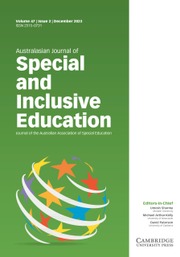Crossref Citations
This article has been cited by the following publications. This list is generated based on data provided by
Crossref.
Garcia-Melgar, Ana
Hyett, Nerida
Bagley, Kerryn
McKinstry, Carol
Spong, Jo
and
Iacono, Teresa
2022.
Collaborative team approaches to supporting inclusion of children with disability in mainstream schools: A co-design study.
Research in Developmental Disabilities,
Vol. 126,
Issue. ,
p.
104233.
Paynter, Jessica
Sulek, Rhylee
Trembath, David
and
Keen, Deb
2022.
Attitudes towards and organizational support for evidence-based practices: A comparison of education and allied health professionals in autism.
Research in Autism Spectrum Disorders,
Vol. 92,
Issue. ,
p.
101932.
Fenwick, Jess
and
Kelly, Stephanie
2023.
Right Here, Right Now: Effective Interprofessional Collaboration in Education from the Perspectives of Primary School Teachers in Aotearoa New Zealand.
New Zealand Journal of Educational Studies,
Vol. 58,
Issue. 1,
p.
201.
2023.
Saint-Supery, Isabeau
Mazon, Cécile
Sauzéon, Hélène
and
Meyer, Éric
2023.
Éthiques inclusives en éducation.
p.
145.
Vodičková, Barbora
Mitašíková, Petra
and
Slavíčková, Mária
2023.
Supportive Factors in Inclusive Mathematics Education: Mathematics Teachers’ Perspective.
Education Sciences,
Vol. 13,
Issue. 5,
p.
465.
Kwok, WingKwan Michelle
Bourke‐Taylor, Helen
Carey, Stuart
and
McKenzie, Maria
2024.
Occupational Therapy Observation Tool–Adjustment Support Details for autistic children: Investigation of content validity and clinical utility.
Australian Occupational Therapy Journal,
Vol. 71,
Issue. 2,
p.
251.
Vlcek, Samantha
Somerton, Michelle
and
Pedersen, Scott
2024.
Stakeholder Collaboration in the Education of Australian Students With Autism Spectrum Disorder: A Systematic Review.
Australasian Journal of Special and Inclusive Education,
Vol. 48,
Issue. 2,
p.
107.
Mpangane, Elmon
Maepa, Mokoena Patronella
and
Muhadisa, Tshimangadzo
2024.
Challenges Faced by Newly Appointed Teachers at Autism- specific School: A Thematic Analysis Study.
The Open Public Health Journal,
Vol. 17,
Issue. 1,
Guerrero, Yeison
Rojas Romero, Cristian Jovan
and
Quintanilla Rubio, Leidy Vanessa
2024.
Participación de las familias en la educación de estudiantes con discapacidad.
Revista Ocupación Humana,
Vol. 24,
Issue. 1,
p.
96.
Tracey, Danielle
2024.
Student Engagement.
p.
243.
Jeremy, Jill
Spandagou, Ilektra
and
Hinitt, Joanne
2024.
Teacher–therapist collaboration in inclusive primary schools: A scoping review.
Australian Occupational Therapy Journal,
Vol. 71,
Issue. 4,
p.
593.
Ryan, Greta
Watchorn, Valerie
and
Evans, Sherryn
2024.
Occupational therapy experiences of interprofessional collaboration in the support of autistic children.
Australian Occupational Therapy Journal,
Vol. 71,
Issue. 6,
p.
1028.
Jeremy, Jill
Spandagou, Ilektra
and
Hinitt, Joanne
2024.
Similarities and Differences Between Perceptions and Practices in Occupational Therapist-Teacher Collaborations: Results from a Mixed-Methods Study.
Journal of Occupational Therapy, Schools, & Early Intervention,
p.
1.
Vlcek, Samantha
Cuskelly, Monica
Somerton, Michelle
and
Pedersen, Scott
2024.
Home–school interactions relating to students with disability: a document analysis of Australian policy and guidelines.
Qualitative Research Journal,
Reed, Phil
and
Osborne, Lisa A.
2024.
Handbook of Early Intervention for Autism Spectrum Disorders.
p.
439.
Jeremy, Jill
Spandagou, Ilektra
and
Hinitt, Joanne
2024.
From individual to inclusive: exploring the spectrum of service delivery models in occupational therapist—teacher collaborations.
The Australian Educational Researcher,
Vlcek, Samantha
and
Somerton, Michelle
2024.
Collaborative engagement between stakeholders in the education of Australian students with disability: a scoping review.
International Journal of Inclusive Education,
Vol. 28,
Issue. 14,
p.
3357.


